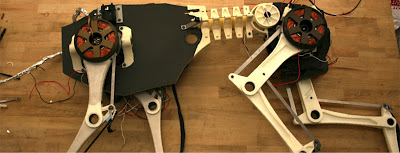Sangbae Kim, professor in mechanical engineering from MIT visited
Berkeley today and gave a great inspiring talk on dynamic locomotion.
The original title of the talk was "Toward Highly Dynamic Locomotion:
Actuation, structure and control of the MIT cheetah robot".

An early model of the cheetah robot. Image (c) biomimetics.
In the talk Sangbae told us about some of the awesome robots (e.g., the
iSprawl fast and dynamic cockroach, or the Gecko stickybot that walks up
walls) they are building in his lab and focused on details of the
cheetah robot, a bioinspired, cheetah-like, quadro-legged robot that
walks, trots, and runs with speeds up to 18.5 miles per hour. While it
was not exactly clear for me why they are building this robot (maybe
because it's just awesome to have a robotic cheetah in your backyard - I
just hope that they do not plan to use those robots to hunt people) he
did a great job on explaining all the different research problems they
had to solve.
The three problems he talked about in detail are:
Power: you need to have enough power to keep the robot running in
the wild for a while. This problem exists even in nature where cheetahs
are completely exhausted after a hunt. Large parts of energy are
dissipated as heat before it can be used to bring the robot into motion.
Some grad students are working on better models that reduce the power
consumption and maximize the time the robot can move. In addition, the
cheetah regenerates power from reverse motion (comparable to
regenerative braking in battery powered electric vehicles).
Motors: a second big problem are reliable motors that deliver high
torque at low speed. Currently the market offers mostly low torque but
high rotation speed motors. These motors are good to build, e.g., a
quadrocopter but they do not work well for a robot as a robot needs
fine-grained control over the motion and sensor feedback (e.g., with how
much force a surface is touched). A low torque high speed motor needs a
gear box between the motor and the tip which makes sensing using just
the motor a hard problem. A high torque low speed motor can directly be
coupled with the tip and functions as a sensor as well, removing the
need for additional sensors and/or complex gear boxes. This simplifies
the design and makes the robots more robust. His lab even switched to
building their own motors for the cheetah that have an optimized design
to offer as much torque as needed.
Stability: wild cheetahs use their tail for stability, to save them
from a fall, or to enable fast direction changes which helps them catch
their prey. Songbae's group added a tail to their cheetah that enables
the robot to recover from miss-steps: "a tail basically buys you time".
If a lateral force pushes the robot to the side then the tail can swing
and counteract that motion. The robot then reacts to the force and has
time to calculate a counter measure.
Video of the running robot. There are a ton more videos on the
biomimetics website.
As a side note: after the talk I wanted to learn more about cheetahs and
watched the following video about real cheetahs. It's a great video
about the cruelty of nature and how hard animals (both beast and prey)
have to fight for survival.
The talk was not focused on computer systems or even computer science
related, nevertheless it was a very accessible and fun talk. I did not
understand all the mechanical and mechatronical details but was able to
follow most of the presented material. And let's just be honest: robots
are awesome and I at least always wanted to build these awesome things!